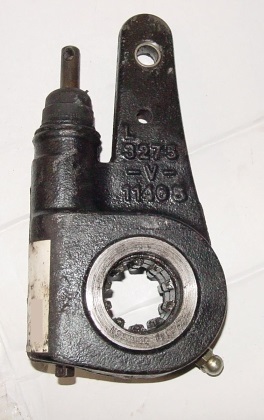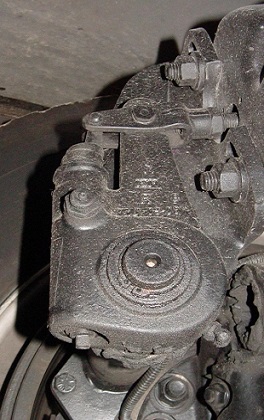To adjust a slack adjuster, turn the adjusting bolt in the appropriate direction. The slack adjuster is an essential component of air brakes in heavy-duty trucks.
It needs to be properly adjusted to ensure the optimal functioning of the brakes. Adjusting the slack adjuster is crucial for maintaining brake performance and safety on the road. When done correctly, it helps prevent brake failure and ensures reliable braking power.
We will explore the process of adjusting a slack adjuster and provide helpful tips for effective adjustment. By following these guidelines, you can ensure that your slack adjuster is properly adjusted and your brakes are performing at their best.
Understanding Slack Adjuster Adjustment
Slack adjuster adjustment is a critical aspect of maintaining a commercial vehicle’s braking system. Properly adjusting slack adjusters ensures that the brakes function efficiently and enhances overall safety on the road.
Introduction To Slack Adjuster Adjustment
Slack adjuster adjustment refers to the process of setting the proper amount of slack in the brake system. It is vital for ensuring that the brakes engage and disengage effectively, allowing for optimal vehicle control and safe braking operations.
Importance Of Proper Slack Adjuster Adjustment
Proper slack adjuster adjustment is crucial for several reasons:
- Enhances Braking Performance:
- Ensures Safety:
- Compliance with Regulations:
Improperly adjusted slack adjusters can lead to brake imbalance, reduced stopping power, and increased risk of accidents. Moreover, regulatory authorities mandate proper slack adjuster adjustment to maintain compliance with safety standards.
In conclusion, understanding slack adjuster adjustment is essential for maintaining the safety and efficiency of a commercial vehicle’s braking system. By adhering to proper adjustment procedures, fleet operators and drivers can ensure optimal braking performance and regulatory compliance.
Types Of Slack Adjusters
A slack adjuster is a crucial component of the braking system in heavy-duty trucks. It ensures the proper functioning of the brakes and helps maintain optimal braking performance. There are two main types of slack adjusters: automatic slack adjusters and manual slack adjusters. Let’s take a closer look at each type and their respective features.
Automatic Slack Adjusters
An automatic slack adjuster (ASA) is a self-adjusting mechanism designed to maintain the correct amount of slack in the brake system. It constantly monitors and adjusts the brake shoe clearance to compensate for brake lining wear.
One of the key advantages of automatic slack adjusters is their ability to compensate for gradual brake lining wear. This ensures consistent brake performance and reduces the need for manual adjustments. ASA’s also help prevent issues such as brake drag, uneven brake pad wear, and excessive stopping distance.
Here are some important points to note about automatic slack adjusters:
- They are comprised of a ratchet mechanism that uses rotational force to adjust the brake shoe clearance.
- Automatic slack adjusters are generally maintenance-free, as they are self-adjusting.
- Certified technicians should be responsible for adjusting automatic slack adjusters to ensure proper setup and functionality.
- It is essential to periodically inspect automatic slack adjusters for signs of wear, damage, or excessive corrosion.
Manual Slack Adjusters
Unlike automatic slack adjusters, manual slack adjusters require periodic manual adjustments to maintain the proper brake shoe clearance. These adjustments compensate for brake lining wear and ensure optimal braking performance. Manual slack adjusters are commonly found in older heavy-duty trucks that do not have automatic adjustment capabilities.
Here are a few key points regarding manual slack adjusters:
- Manual adjustments should be made by qualified technicians who are familiar with the specific adjustment procedures.
- Inspecting manual slack adjusters regularly is crucial to identify any signs of wear, damage, or excessive corrosion.
- Proper lubrication of the manual slack adjuster is necessary to ensure smooth operation and prevent premature wear.
- It is essential to adhere to the manufacturer’s recommended maintenance intervals for manual slack adjusters.
Understanding the different types of slack adjusters is vital for ensuring the safe and efficient operation of heavy-duty truck brakes. Whether you have automatic or manual slack adjusters, proper maintenance and inspections are crucial to prevent brake-related issues and ensure optimal braking performance.
Adjusting Automatic Slack Adjusters
Automatic slack adjusters are an essential component of any heavy-duty truck’s braking system. They ensure that the brakes are always adjusted properly, which is crucial for safe and efficient operation. In this section, we will discuss how to adjust automatic slack adjusters, troubleshoot common issues, and the tools required for the adjustment process.
Troubleshooting Automatic Slack Adjusters
Before adjusting automatic slack adjusters, it is important to identify any potential issues. Here are some common problems that may arise:
- Uneven brake lining wear
- Excessive brake drum heat
- Brake dragging or squealing
If you notice any of these issues, it is essential to address them before adjusting the slack adjuster.
Tools Required For Adjustment
To adjust automatic slack adjusters, you will need the following tools:
- Standard wrench set
- Brake adjustment tool
- Torque wrench
- Safety glasses
Having these tools readily available will ensure a smooth and efficient adjustment process.
Step-by-step Guide To Adjusting Automatic Slack Adjusters
Follow these steps to adjust automatic slack adjusters:
- 1. Park your vehicle on a level surface and engage the parking brake.
- 2. Locate the slack adjuster on each wheel. It is normally positioned between the push rod and the brake chamber.
- 3. Measure the brake drum clearance. Refer to the manufacturer’s guidelines for the recommended clearance.
- 4. Using a wrench, loosen the locknut on the slack adjuster.
- 5. Turn the adjusting screw clockwise to increase the brake drum clearance or counterclockwise to decrease it.
- 6. Check the brake drum clearance again and make further adjustments if necessary.
- 7. Tighten the locknut on the slack adjuster to secure the adjustment.
- 8. Repeat this process for all slack adjusters on the vehicle.
Following these steps will ensure that your automatic slack adjusters are properly adjusted, allowing for optimal brake performance and safety.
Credit: www.cdc.gov
Adjusting Manual Slack Adjusters
Properly adjusting manual slack adjusters ensures optimal brake performance and vehicle safety. Regular maintenance and thorough inspection play a crucial role in keeping your slack adjusters functioning efficiently. By following manufacturer guidelines and utilizing the correct tools, you can easily adjust slack adjusters to maintain brake system effectiveness.
Adjusting Manual Slack Adjusters Manual slack adjusters play a crucial role in maintaining the effectiveness and safety of a vehicle’s braking system. Proper adjustment of these components is vital to ensure optimal performance and compliance with legal regulations. This article will provide an overview of the functionality of manual slack adjusters, followed by detailed procedures for their adjustment.Functionality Of Manual Slack Adjusters
Manual slack adjusters are critical components in a vehicle’s air brake system, responsible for maintaining the correct clearance between the brake lining and the drum. This clearance, or slack, needs to be adjusted periodically to ensure efficient braking performance and compliance with safety standards. Manual slack adjusters achieve this by regulating the travel distance of the pushrod, ultimately determining the braking force applied by the brake lining. The proper functionality of manual slack adjusters is essential for ensuring safe and reliable braking.Procedures For Manual Slack Adjuster Adjustment
The adjustment process for manual slack adjusters involves several distinct steps to ensure accurate and reliable performance. It is essential to follow these procedures meticulously to guarantee the effectiveness and safety of the braking system. The following steps outline the correct approach to adjusting manual slack adjusters: 1. Inspect the Current Slack: Begin by measuring the slack in the braking system to determine if adjustment is necessary. This can be done using a suitable tool to gauge the pushrod’s travel distance. Identifying the current slack level is crucial for determining the required adjustment. 2. Locate the Adjuster: Once the slack measurement is determined, locate the manual slack adjuster on the vehicle. This may require accessing the braking components and identifying the specific adjuster requiring adjustment. 3. Adjusting the Slack: Using the appropriate tools and techniques, proceed to adjust the slack in the manual slack adjuster. This involves turning the adjusting nut in the necessary direction to increase or decrease the pushrod travel distance as per the measured slack. 4. Reinspect Pushrod Travel: After making the necessary adjustments, reinspect the pushrod travel to ensure that the correct slack has been achieved. It is essential to verify the effectiveness of the adjustment to guarantee the proper functioning of the braking system. 5. Test Braking Performance: Finally, perform a series of brake tests to evaluate the effectiveness of the adjusted manual slack adjuster. This step is crucial for confirming that the adjustment has resulted in the desired braking performance and compliance with safety standards. By adhering to these procedures, manual slack adjusters can be accurately adjusted to ensure optimal functionality and safety within a vehicle’s braking system. Regular and meticulous adjustment of manual slack adjusters is critical for maintaining efficient braking performance and adhering to legal requirements.Best Practices For Maintaining Slack Adjusters
Regular Inspection And Maintenance
Regular inspection and maintenance are crucial to ensure the proper functioning of slack adjusters. Inspect for wear and tear routinely.
Common Issues And Solutions
Identify common issues such as loose components and excessive slack. Solutions may involve adjusting the slack adjuster and replacing worn parts.
Safety Precautions
- Always follow safety guidelines while working on slack adjusters.
- Wear appropriate protective gear to prevent injuries.
- Ensure the vehicle is securely supported before performing adjustments.
Credit: m.youtube.com
Credit: www.cdc.gov
Frequently Asked Questions On Slack Adjuster Adjustment
How Do You Adjust Slack Adjusters?
To adjust slack adjusters, turn the adjusting bolt either clockwise or counterclockwise depending on its orientation. Always ensure proper brake adjustment by following the manufacturer’s guidelines. Regularly check and grease the slack adjuster to maintain optimal performance. Only certified technicians should perform adjustment on automatic slack adjusters.
How Much Slack Should Slack Adjusters Have?
Slack adjusters should have minimal slack, ideally none at all. It is important to ensure that slack adjusters are properly adjusted to maintain the effectiveness and safety of the braking system.
Do Automatic Slack Adjusters Need To Be Adjusted?
Properly installed and lubricated automatic slack adjusters should not need adjustment after initial setup. A manually adjusted out-of-adjustment brake stroke should not be corrected by adjusting the slack adjuster.
What Is The Proper Angle For A Slack Adjuster?
The proper angle for a slack adjuster should be at 90 degrees to the pushrod. This allows for effective brake adjustment.
Conclusion
Understanding the proper way to adjust a slack adjuster is crucial for maintaining the safety and efficiency of your heavy-duty truck. By following the correct procedures, such as using the right tools and ensuring compliance with regulations, you can avoid potential brake issues.
Remember, safety comes first.


